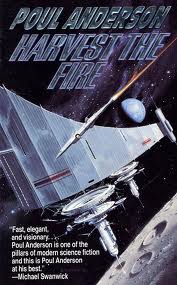Incredibly, Poul Anderson keeps the series going. Despite the cosmic climax of Harvest of Stars and despite the comparable culmination of the succeeding volume, The Stars Are Also Fire, the future history presented in these two long novels provides sufficient background material to generate a narrative framework and what has by now become a familiar setting for two further novels. Of these two additional volumes, the first, Harvest The Fire (New York, 1995), begins:
"Once in his drifting to and fro across Earth, Jesse Nicol found a quivira left over from olden times." (p. 9)
Jesse Nicol is a new character but two features of this opening sentence are familiar: a future Earth on which there is freedom to drift and a virtual reality machine called a "quivira." Nicol generates a virtual interview with Jorge Luis Borges. The cybercosm scans databases "...to synthesize a personality and a setting..." (p. 16) The cybercosm is conscious but it is not made clear whether the simulated Borges has a temporary consciousness of being interviewed by Nicol. Generation of such a temporary consciousness does occur in virtual realities in other Anderson works.
Authentically, the virtual Borges gives Nicol a signed copy of one of his books. Nicol finds this "...heartbreaking.." and afterwards "...glanced down at his hand, as if it held a book." (pp. 29, 30) The cybercosm could have completed the illusion by printing a facsimile book with a forged signature.
Anderson readers are confident that, when this author extends, e.g., the "Harvest Of Stars" sequence or the earlier Technic History, the new work will be a substantial addition to the existing series whereas the appearance of the word Foundation or Dune in a new sf title signifies only the monotony of a recurring decimal.

No comments:
Post a Comment